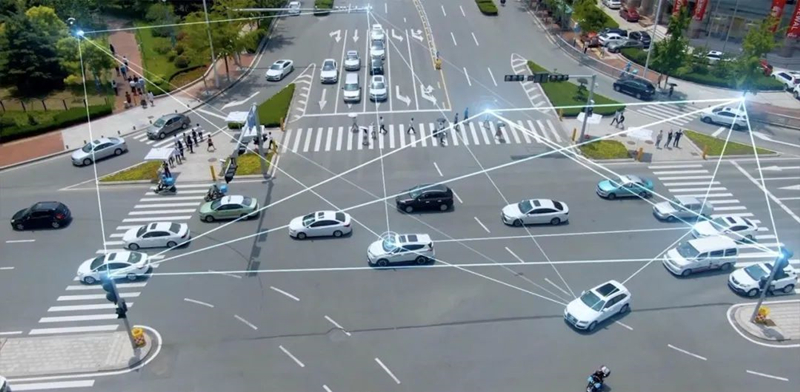Application of Millimeter Wave Radar in V2X

With the rapid development of intelligent transportation systems, Vehicle to Everything (V2X) systems have gradually become an important means of improving road safety, traffic efficiency, and energy utilization efficiency. The vehicle road collaboration system utilizes wireless communication technology to achieve information exchange between vehicles (V2V), vehicles and infrastructure (V2I), and vehicles and pedestrians (V2P), aiming to build a highly intelligent transportation ecosystem. In this system, perception technology is the foundation for achieving vehicle road coordination, and millimeter wave radar, as one of the key perception devices, has become an indispensable component of the vehicle road coordination system due to its stable performance and high-precision target detection ability under adverse weather conditions.
The working principle of millimeter wave radar
Millimeter wave radar typically uses frequency modulated continuous wave (FMCW) technology, which measures the distance and velocity of targets by emitting electromagnetic waves with a frequency that varies linearly over time. When the electromagnetic waves emitted by the radar encounter the target, some of the electromagnetic waves will be reflected back. The radar receives these echoes and processes them to obtain information such as the target’s position, velocity, direction, etc. Compared with traditional single target radar, millimeter wave radar can detect multiple targets at the same time and provide more detailed target information, such as target size, shape, and motion status.
The role of millimeter wave radar in vehicle road coordination system
Millimeter wave radar plays an important role in the vehicle road coordination system, mainly reflected in the following aspects:
1. Improving driving safety:
Intelligent intersection: At urban intersections, millimeter wave radar can monitor traffic conditions in real time, including vehicle speed, location, and direction of travel. By combining with traffic signal control systems, millimeter wave radar can achieve intelligent signal control, such as dynamically adjusting the timing of signal lights based on real-time traffic flow, reducing waiting time and congestion. In addition, millimeter wave radar can also be used to detect the activities of pedestrians and cyclists, providing necessary warning information for autonomous vehicles and avoiding potential safety hazards.

Intelligent highway: In highway scenarios, millimeter wave radar can be used to monitor the speed, position, and driving status of vehicles, thereby achieving precise control of traffic flow. For example, when traffic congestion or accidents are detected ahead, millimeter wave radar can promptly issue warnings to vehicles in the rear, prompting them to slow down or change lanes to avoid secondary accidents. In addition, millimeter wave radar can also be used to detect illegal overtaking, reverse traffic and other violations, improving the level of road safety management.
2. Improve traffic efficiency:
Intelligent parking lot: In the parking lot scene, millimeter wave radar can be used to monitor the occupancy of parking spaces, providing drivers with real-time parking information and reducing the time spent searching for parking spaces. Meanwhile, millimeter wave radar can also be used to detect pedestrian activities in parking lots and prevent collisions between vehicles and pedestrians. In addition, millimeter wave radar can also be used to achieve automatic parking function, by accurately detecting obstacles around the vehicle, helping the vehicle to park safely in the parking space.
Vehicle formation driving: In autonomous driving fleets, millimeter wave radar can be used to achieve precise distance control between vehicles, ensuring the safety and stability of the fleet during driving. Millimeter wave radar can monitor the position and speed of the preceding vehicle in real time, providing necessary obstacle avoidance information for the following vehicle and avoiding rear end collisions. In addition, millimeter wave radar can also be used to monitor the traffic conditions around the convoy, providing comprehensive environmental perception information for the convoy and improving the overall driving efficiency of the convoy.
3. Supporting autonomous driving
Millimeter wave radar also plays a key role in supporting autonomous driving. Autonomous vehicles require real-time perception of the surrounding environment to make correct decisions. Millimeter wave radar can provide high-precision target detection and tracking information, helping autonomous vehicles identify and classify surrounding vehicles, pedestrians, and other obstacles. These pieces of information can be used for functions such as path planning, obstacle avoidance, and navigation to ensure safe and efficient driving of vehicles.
4. Implementing intelligent traffic management
Millimeter wave radar can be used to achieve intelligent traffic management and improve the overall efficiency of the transportation system. By installing millimeter wave radar on the roadside, real-time monitoring of traffic flow, speed, and traffic events can be achieved. These information can be used for application scenarios such as traffic flow prediction, traffic signal optimization, and traffic event response. For example, when an abnormal increase in traffic flow is detected on a certain road section, the timing of traffic signals can be adjusted in a timely manner to guide vehicles to divert and avoid traffic congestion. In addition, millimeter wave radar can also be used to detect traffic accidents and malfunctioning vehicles, dispatch rescue teams in a timely manner, and reduce traffic delays.
The integration of millimeter wave radar and other perception technologies
Although millimeter wave radar performs well in vehicle road coordination systems, it also has its own limitations, such as limited ability in target classification and recognition. Therefore, integrating millimeter wave radar with other perception technologies (such as LiDAR, cameras, etc.) can compensate for their respective shortcomings and achieve more comprehensive and accurate environmental perception. For example, LiDAR can provide high-precision 3D point cloud data for precise modeling and classification of targets; Cameras can provide rich visual information for target behavior analysis and semantic understanding. Through multi-sensor data fusion technology, multi-dimensional perception of the traffic environment can be achieved, providing more reliable data support for vehicle road collaboration systems.
